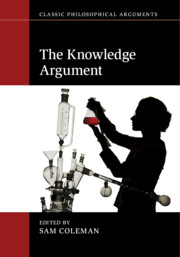Book contents
- The Knowledge Argument
- Classic Philosophical Arguments
- The Knowledge Argument
- Copyright page
- Contents
- Contributors
- Introduction: The Enduring Significance of Jackson’s Knowledge Argument
- 1 The Knowledge Argument Is an Argument about Knowledge
- 2 There’s Nothing about Mary
- 3 Acquaintance, Parsimony, and Epiphenomenalism
- 4 Acquaintance and Phenomenal Concepts
- 5 The Knowledge Argument Meets Representationalism about Colour Experience
- 6 The Mary-Go-Round
- 7 Concept Mastery, Social Externalism, and Mary’s New Knowledge
- 8 Mary’s Powers of Imagination
- 9 The Knowledge Argument Is Either Indefensible or Redundant
- 10 Grounding, Analysis, and Russellian Monism
- 11 Phenomenal Knowledge Why: The Explanatory Knowledge Argument against Physicalism
- 12 The Knowledge Argument and the Self
- 13 What Uninformed Mary Can Teach Us
- Bibliography
- Index
8 - Mary’s Powers of Imagination
Published online by Cambridge University Press: 09 September 2019
- The Knowledge Argument
- Classic Philosophical Arguments
- The Knowledge Argument
- Copyright page
- Contents
- Contributors
- Introduction: The Enduring Significance of Jackson’s Knowledge Argument
- 1 The Knowledge Argument Is an Argument about Knowledge
- 2 There’s Nothing about Mary
- 3 Acquaintance, Parsimony, and Epiphenomenalism
- 4 Acquaintance and Phenomenal Concepts
- 5 The Knowledge Argument Meets Representationalism about Colour Experience
- 6 The Mary-Go-Round
- 7 Concept Mastery, Social Externalism, and Mary’s New Knowledge
- 8 Mary’s Powers of Imagination
- 9 The Knowledge Argument Is Either Indefensible or Redundant
- 10 Grounding, Analysis, and Russellian Monism
- 11 Phenomenal Knowledge Why: The Explanatory Knowledge Argument against Physicalism
- 12 The Knowledge Argument and the Self
- 13 What Uninformed Mary Can Teach Us
- Bibliography
- Index
Summary
In contemporary discussions of philosophy of mind, Frank Jackson’s story of Mary is a familiar one (Jackson 1982, 1986). Though Mary has spent her entire life locked inside a black-and-white room and has never seen color, she has nonetheless mastered color science. When she is released from her room and sees a ripe tomato for the first time, it seems that she learns something – that she comes to know what seeing red is like. But if Mary did not know all there was to know about color while in the room, and thus if there are facts over and above the physical facts about color, then physicalism is threatened. The standard physicalist responses to this argument, typically referred to as the knowledge argument, are also by now familiar. While some deny that Mary learns anything at all about color and color experiences upon her release from the room – how could she, given that she already has all the physical information there is to have about color and color experiences? – others acknowledge the power of the intuition that Mary has an “Aha!” moment when she exits the room and are slightly more concessionary. Such concessionary responses typically grant that Mary learns something upon her release but deny that this threatens physicalism. Rather, her learning should be understood to consist in the acquisition of abilities, or in her newfound acquaintance with color, or in her apprehension of an old fact under a new guise.
- Type
- Chapter
- Information
- The Knowledge Argument , pp. 161 - 179Publisher: Cambridge University PressPrint publication year: 2019
- 5
- Cited by



